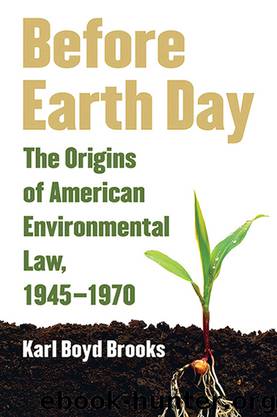Before Earth Day by Karl Boyd Brooks

Author:Karl Boyd Brooks
Language: eng
Format: epub
ISBN: 9780700623181
Publisher: University Press of Kansas
Published: 2016-11-16T05:00:00+00:00
FOOTHOLD IN THE AIR: CLEAN AIR LAWMAKING
Two Los Angeles law professors wrote the first draft of air quality regulation’s postwar history. James Krier and Edmund Ursin, Harvard Law graduates teaching at UCLA by 1977, wrote Pollution and Policy: A Case Essay on California and Federal Experience with Motor Vehicle Pollution, 1940–1975, to stress the continuities and contingencies that created state and federal laws to control air pollution. Their book’s title evoked environmental law’s postwar incrementalism. They wanted lawyers and policymakers to analyze legal developments in air quality control as a historic continuum between 1940 and 1975 because “at least in this instance, the past has indeed been prologue in many important respects.”22
The Californians’ explanation of postwar air quality lawmaking detected two historic patterns: states and localities made the first important strides in cleaning the air and the national government nationalized clean air law well before the seventies. “The events on which we focus are typical of most environmental problems,” Krier and Ursin contended. “History,” they argued, “especially the history of policy made in a many-layered federal system, does not develop in a nice linear progression of significant event followed by significant event.” Rather, “the process of making pollution policy . . . has been one of least steps along the path of least resistance, [its] history far more one of reaction than initiative [as] events, not foresight, ushered in each stage of intervention.” When governments intervened by making new laws, state action “tended to consist in curative rather than preventive measures . . . designed to preserve so far as possible the prevailing social patterns—whether of business practice, citizen behavior, or the distribution of authority among local, state, and federal governments.” Representatives Blatnik and Cramer in 1961 had come to the same conclusions: environmental lawmaking was not a federal preserve, nor the New Frontier of the 1960s a distinct, revolutionary moment.23
Krier and Ursin’s air law history described a postwar lawmaking line dance that moved to federalism’s rhythmic refrain. Technological innovation, cultural responses, and economic reverberations punctuated the cumulative process of legal change. To cope with worsening air pollution, big states and populous local governments initiated postwar lawmaking. As Chapter 4 showed, California led the way in 1947. Water quality law emerged in much the same way after World War II, originating in Harrisburg, Sacramento, Albany, and Columbus before Capitol Hill or 1600 Pennsylvania Avenue took much notice. State leadership then prompted federal financial assistance, which invariably generated political pressures for federal intervention when the environmental problems proved intractable. This long process of legal change helps explains why the same Congress that extended federal water pollution enforcement authority in 1956 also enacted the pioneering 1955 Air Pollution Control Act (APCA). “The years 1954–1955 were the first of real significance with regard to development of a federal interest in air pollution,” Krier and Ursin found. Nature’s own agency—a serious November 1953 smog incident in New York City—stimulated renewed pressure for national action from people living in larger states and municipalities.24
Two Republican senators,
Download
This site does not store any files on its server. We only index and link to content provided by other sites. Please contact the content providers to delete copyright contents if any and email us, we'll remove relevant links or contents immediately.
Second Nature (The Shape-Shifter Series #1) by Jae(1051)
Petroleum Contracts by Peter Roberts(866)
The Global Commons by Susan J. Buck(863)
Infrastructure by Frischmann Brett M(810)
The Monk by Matthew Lewis(790)
Japan Travel Guide: Things I Wish I Knew Before Going To Japan (2019 EDITION) by Fukuyama Ken & Fukuyama Yuki(773)
Ever After by William Wharton(743)
Before Earth Day by Karl Boyd Brooks(714)
Good for You, Great for Me by Lawrence Susskind(708)
War of the Whales by Joshua Horwitz(685)
Biting the Hands that Feed Us by Baylen J. Linnekin(676)
Respecting Animals by David S. Favre(655)
Uncommon Ground by William Cronon(652)
Animal Law in a Nutshell by Frasch Pamela & Hessler Katherine & Waisman Sonia(651)
After Nature: A Politics for the Anthropocene by Jedediah Purdy(641)
Rangeland Systems by David D. Briske(640)
The Ethics of Space Exploration by James S.J. Schwartz & Tony Milligan(632)
Fracking the Neighborhood by Jessica Smartt Gullion(607)
Down to the Wire: Confronting Climate Collapse by David W. Orr(598)
